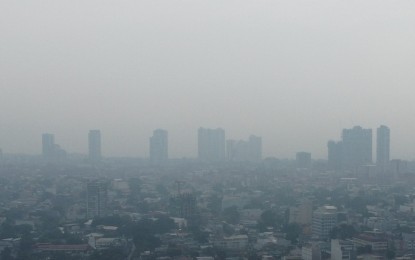
MANILA – The Department of Environment and Natural Resources-Environmental Management Bureau (DENR-EMB) said the foggy atmosphere in the National Capital Region (NCR) on Monday was mainly due to air pollution from vehicular emissions and not vog coming from Taal Volcano.
“The current air pollution levels may be primarily attributed to emissions from heavy vehicular traffic, especially during rush hour, and the effect of thermal inversion which traps air pollutants in the surface level,” the DENR’s Haze Watch Air Quality Technical Bulletin read.
The surface wind direction is blowing from the southeast at about 8 a.m., as observed from the nearest station of PAGASA (Philippine Atmospheric, Geophysical and Astronomical Services Administration) located approximately 33.3 kilometers from Taal Volcano.
This means that the wind direction is away from the NCR, it added.
Meanwhile, air quality in some areas in Metro Manila was recorded at unhealthy levels.
The DENR-EMB air monitoring station in Makati City recorded an air quality index (AQI) of “very unhealthy” for Particulate Matter (PM) 2.5, while stations in Caloocan, Pateros, and Parañaque City recorded an AQI of “unhealthy for sensitive groups” for PM2.5.
Stations in Pateros and Taguig City recorded AQI of “fair” (55-154) for PM10, while stations in Caloocan, San Juan, Makati, and Parañaque City recorded AQI of “good” for PM10 (range from 0–54).
Meanwhile, an AQI of “very unhealthy” was recorded for ground-level upwind PM2.5 monitoring stations located in SM Skyranch, Tagaytay, Cavite; and BSU Mabini Campus Rizal Ave, Extension, Batangas — all near Taal Volcano.
However, air quality varies in time and place and can change anytime depending on pollution sources and meteorological factors.
Meanwhile, vog was recorded in areas near the Taal Volcano which is under Alert Level 1.
The Philippine Institute of Volcanology and Seismology (Phivolcs) recorded 3,355 tonnes/day of sulfur dioxide emissions within the area and a plume height of 2,400 meters. (PNA)






